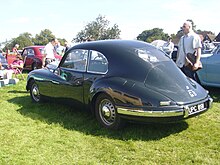Bristol 403
| Bristol | |
|---|---|
|
Bristol 403. The exterior mirror was retrofitted.
|
|
| 403 | |
| Production period: | 1953-1955 |
| Class : | Upper class |
| Body versions : | Coupe |
| Engines: |
Otto engine : 2.0 liters (74 kW) |
| Length: | 4864 mm |
| Width: | 1702 mm |
| Height: | 1524 mm |
| Wheelbase : | 2898 mm |
| Empty weight : | 1350 kg |
| Previous model | Bristol 401 |
| successor | Bristol 405 |
The Bristol 403 was a sports car produced by the British car manufacturer Bristol Aircraft Company (later: Bristol Cars ), which replaced the very similarly designed Bristol 401 in 1953 .
Development history
The 403 differed from its predecessor in a number of technical changes which, according to the British trade press, "turned an already excellent car into a unique one".
The most important technical innovation was the introduction of a more powerful engine, a version of the well-known six-cylinder called 100A, which could now deliver an output of 100 hp (75 kW) at 5000 revolutions per minute. The valves were enlarged for this purpose. The crankshaft got stronger journals with 54 instead of 51 mm diameter. The increase in performance increased the top speed of the 403 to over 100 miles per hour (approx. 160 km / h). At the same time, the engine's pulling power increased noticeably in the medium speed range from 2,500 revolutions per minute. Other changes included the introduction of new, stronger brakes with a drum diameter of 28 cm, which took into account the higher top speed of the car. At the same time, the amount of effort that was previously felt to be considerable when the brake pedal was pressed has been reduced. Changes to the front axle finally eliminated the tendency to oversteer that was criticized in the 401.
The aerodynamically highly developed body of the 401, however, remained largely unchanged. The few external changes related to new lighting units and modified emblems. The split windshield was also retained. At the customer's request, two vehicles were subsequently given a one-piece windshield, which in at least one case was taken from the Morris Minor . Apart from a single, externally manufactured convertible, which differed in the rear from the factory 402 , no special bodies were made for the Bristol 403.
The 403 was the last Bristol car to feature the BMW “kidney” grille. 300 copies were made.
literature
- RM Clarke: Bristol Cars: A Brooklands Portfolio: 132 Contemporary Articles Drawn from International Motoring Journals , UK 2001 (engl.)
- LJK Setright : A private car , 2 volumes, UK 1999 (engl.)
- LJK Setright: Bristol Cars and Engines , UK 1974, ISBN 978-0-900549-22-9 (English)
- NN: A German-English classic. The history of the Bristol brand . In: Classic Cars Spezial - English classic cars. June / July / August 1994, p. 6 ff.
- Frank Oleski and Hartmut Lehbrink: Series sports cars . 1983/1993 (Könemann), ISBN 3-89508-000-4 .
- Dean Bachelor, Chris Poole, Graham Robson: The Big Book of Sports Cars ; Erlangen 1990 (no ISBN)
- John Bolster tests the Bristol 403. In: Autosport, August 28, 1953.
- More Power for Bristol - 403 . In: Wheels, June 1953 issue.
- Bristol evolves still further . Very detailed description of the technology of the Bristol 403 in: Autocar from May 15, 1953.
Web links
Individual evidence
- ^ John Bolster tests the Bristol 403. In: Autosport of August 28, 1953.
- ↑ http://www.gbclassiccars.co.uk/bristol_401_403.html
- ^ John Bolster tests the Bristol 403 . In: Autosport from August 28, 1953.
- ↑ More Power for Bristol - 403 . In: Wheels, June 1953 issue.
- ↑ Overview of the model history on the Bristol Owners Club website.
- ↑ Model history at howstuffworks.com
| Vehicle class | Body versions | 1940s | 1950s | 1960s | 1970s | 1980s | 1990s | 2000s | 2010s | 2020s | ||||||||||||||||||||||||||||||||||||||||||||||||||||||||||||||||||
| 6th | 7th | 8th | 9 | 0 | 1 | 2 | 3 | 4th | 5 | 6th | 7th | 8th | 9 | 0 | 1 | 2 | 3 | 4th | 5 | 6th | 7th | 8th | 9 | 0 | 1 | 2 | 3 | 4th | 5 | 6th | 7th | 8th | 9 | 0 | 1 | 2 | 3 | 4th | 5 | 6th | 7th | 8th | 9 | 0 | 1 | 2 | 3 | 4th | 5 | 6th | 7th | 8th | 9 | 0 | 1 | 2 | 3 | 4th | 5 | 6th | 7th | 8th | 9 | 0 | 1 | 2 | 3 | 4th | 5 | 6th | 7th | 8th | 9 | 0 | ||
| Upper class | limousine | 405 | ||||||||||||||||||||||||||||||||||||||||||||||||||||||||||||||||||||||||||
| Coupé / convertible | 400 | 403 | ||||||||||||||||||||||||||||||||||||||||||||||||||||||||||||||||||||||||||
| 401 | 405 | 406 | 407 | 408 | 409 | 410 | 411 | 603 | Brigand | Blenheim | ||||||||||||||||||||||||||||||||||||||||||||||||||||||||||||||||||
| 402 | Britannia | |||||||||||||||||||||||||||||||||||||||||||||||||||||||||||||||||||||||||||
| Sports car | Coupé / convertible / roadster | 404 | 406 Zagato | 412 | Beaufighter | Blenheim Speedster | Bullet | |||||||||||||||||||||||||||||||||||||||||||||||||||||||||||||||||||||
| Arnolt-Bristol | Fighter | |||||||||||||||||||||||||||||||||||||||||||||||||||||||||||||||||||||||||||
| race car | - | 450 | ||||||||||||||||||||||||||||||||||||||||||||||||||||||||||||||||||||||||||


